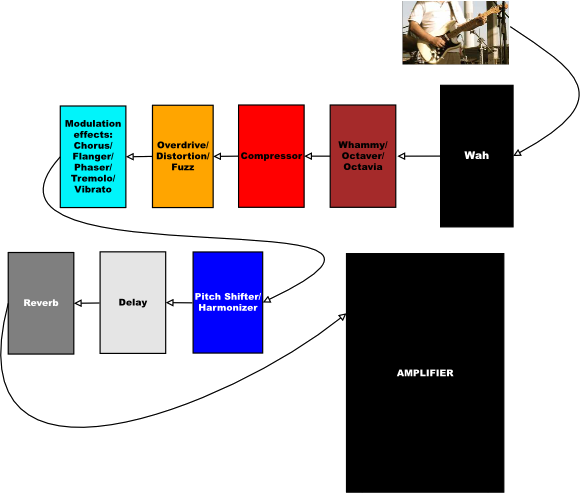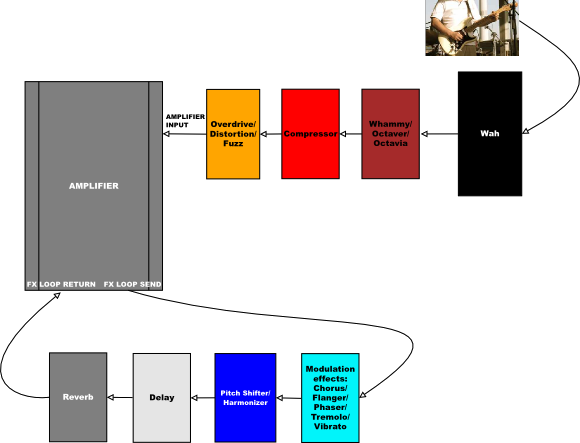This post is part of my “Effects FAQ” series explaining guitar effects basics. A very common question is: “where should I plug my pedals in the effect chain?”.
So I have put on schematics what is thought to be the most optimal guitar effect order for most styles to avoid for instance, plugging a reverb before a distortion which produces a very mushy sound. And so it goes for most effect combinations.
A word of advice on this though: often in music, rules are meant to be broken and experimenting to find your tone is highly recommended!
Case 1: All your effects are plugged before an amp that has no “Effects Loop”
The first case is where you run all your pedals before the input of your amplifier i.e. your amplifier has no Effects Loop or you are not using it. The amp would be presumably set quite clean. You don’t want to run a delay or a reverb in front of an overdriven amp as this can sound quite mushy. Click on the image to see a larger version.
Remarks:
- You could argue that the Whammy is a pitch shifter but there are two types of pitch shifters and each type might work better in different places in the chain. You could place a Whammy after your distortion but the “tracking” is usually better before. More sophisticated digital pitch shifters/harmonizers like the Eventide kind sound better after a distortion/overdrive (think Brian May of Queen).
- Modulation effects like chorus or flanger can be placed before a distortion but the sound will be quite different from when they are placed after. As I said, just experiment!
Case 2: if you own an amplifier equipped with an Effects Loop (a.k.a. FX Loop)
Some effects like delay or reverb sound clearer if they are placed after a distortion/overdrive. In order to use these effects after the natural overdrive of your amp, the amplifier gods created the effects loop. It translates into an “FX LOOP SEND” connector that goes into the “INPUT” of your effect and an “FX LOOP RETURN” connector that goes to the “OUTPUT” of your effect. Here is how it goes:
Remarks:
The loop is placed in between the two main parts of any amp: the preamp and the power section. Most modern amps get their natural overdrive from the preamp and then the signal goes through the effects loop and is amplified quite cleanly by the power section. Cleanly means that effects like delays and reverb stay “clear”.
This is different from earlier amps which had no master volume let alone effect loops (think old tube Marshall, Fender and VOX amps). With these or their reissues still sold today, in order to get any distortion, you have to crank the volume to make both the preamp and the power section saturate. This is sometimes referred to as “power tube saturation”. Some guitarists like Eric Clapton or Jeff Beck love power tube saturation which explains why they still tend to use older amps that they crank.
To add some “crystal clear” reverb or delay to “power tube saturation”, you can put a microphone in front of the amp and add the effects to the signal picked up by said microphone. Or you can use a power attenuator like the THD Hotplate which can absorb the power of an amp and turn most of it into heat as well as provide a “line level” signal. This can then be used with effects before it has to be re-amplified. Not as easy as an amp with an effects loop or the use of pedals in front of a clean amp! But some guitarists really want the tone provided by “power tube saturation”.



Nice! Until now, I never really fully understood the effect loop.
Thank you sir!
In the “Case 2” diagram where would you place a volume pedal? Hi-Z or Low-Z?
You might want to do two different things with a volume pedal:
1) Place it first in your chain to do some swell effect or reduce the amount of dirt by lowering the volume before your distortion/overdrive pedals. In this case, a Hi-Z is recommended.
2) Place the volume in your effects loop, before or after the modulation/delay/reverb, it does not matter. In this case, when you use it, the amount of dirt in your tone will stay the same since the pedal will be placed after the distortion/overdrive but you will be able to change the volume of your overall tone. Low-Z is fine for this.
The Low-Z/Hi-Z thing is a bit of a debate, some say even a Hi-Z volume pedal placed first in your chain will affect your tone no matter what. So some people prefer to use a Low-Z but not to place it first. There are also active volume pedals like the Morley Steve Vai or the Visual Volume by Visual Sound which tries to address these issues. In any case, trying before buying is important.
Interesting,
Cheers!
Would you place a rotary speaker simulator like the Boss RT-20 or a univibe same place you show the modulation effects ?
I keep thinking a rotary sim should be the last fx in the chain before it’s output sends to 2 different amps.
Hi. I think two placements are valid depending on the tone you are looking for:
1) Quite early in the chain (even before the overdrive/distortion) for a “dirty” kind of rotary tone (think Hendrix).
2) Last in the chain for a more beautiful stereo tone
I have shown in my flanger and phaser posts that both placements yield interesting results. So I’d say, experiment!
I’m having problems of getting that boost from an Overdrive pedal for leads… My pedal Board is currently set up as follows: Tuner-Volume Pedal-Wah-OD-EQ, On my effects loop is Chorus-Delay-noise supressor….. Thats it…Pretty simple, just cant get enough for leads….. Any suggestions?
Hi, the order looks perfectly fine. What amp do you use? Are you looking for a “big lead tone” kind of sound?
@ Dennis: Why don’t you add a buffer in the beggining or right after wah if it is old-style, and a treble booster in the end? Try short cables or with low capacitance(good quality). Probably not all of your pedals are true bypass. I hope this will help you.
Thaaaaaanks!!! Really Useful
Awesome Site.
Greetings from Chile
I think experiment and experience are the best teacher of this, in order to test it all..
Hey so I own a Morley Wah, TC Electronics Flashback Delay, Electro Harmonix Small Stone Nano, Modtone Funk Filter Enveloper, and a Korg Pitchblack Tuner. How should I arrange these on my pedalboard?
Do you have any distortion device?
I would go tuner then wah then envelopper then small stone then TC Flashback delay.
But you could put the small stone after the delay, it’s a matter of taste and experimentation.
Where would a Guitar/Bass Synthesizer go best? Like a Boss SYB-5 or a Behringer BSY 600, or the more expensive ones like the Pigtronix Mothership? I Usually use it before the distortion/overdrive so I get a clean signal into the synth but I’ve gotten a pretty sick tone if I use a fuzz before the synth and mix in both the synth affected sound and the dry fuzz sound.
It’s really up to you, this type of effect can be placed before or after, there are no absolute rules. Whatever you like!
I’ve found that by applying delay in the effects loop of my amp, I end up with a much cleaner and more controllable delay effect. I also did a post on this on my blog, take a look: http://www.playguitarlive.com/how-to-order-your-effects-pedals/
I’m just learning this stuff and your treatment on the subject was very helpful. Thank you very much.